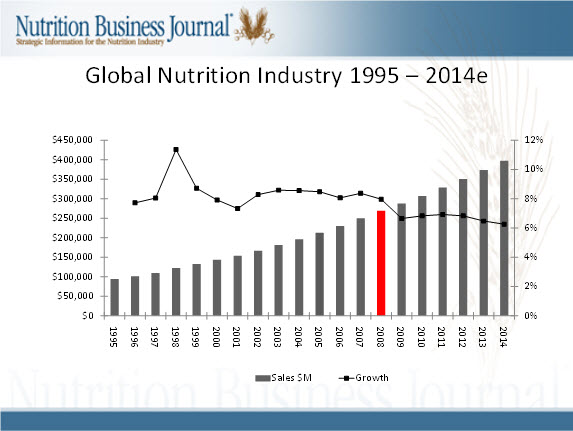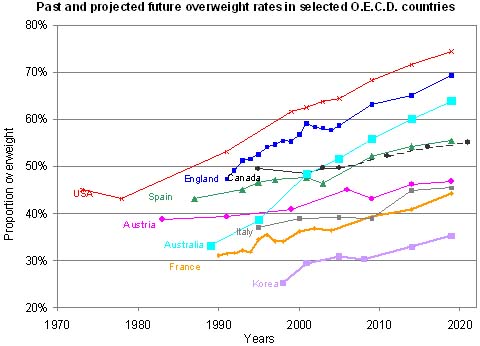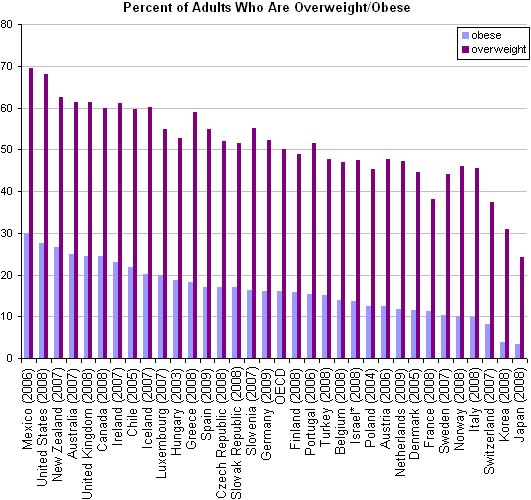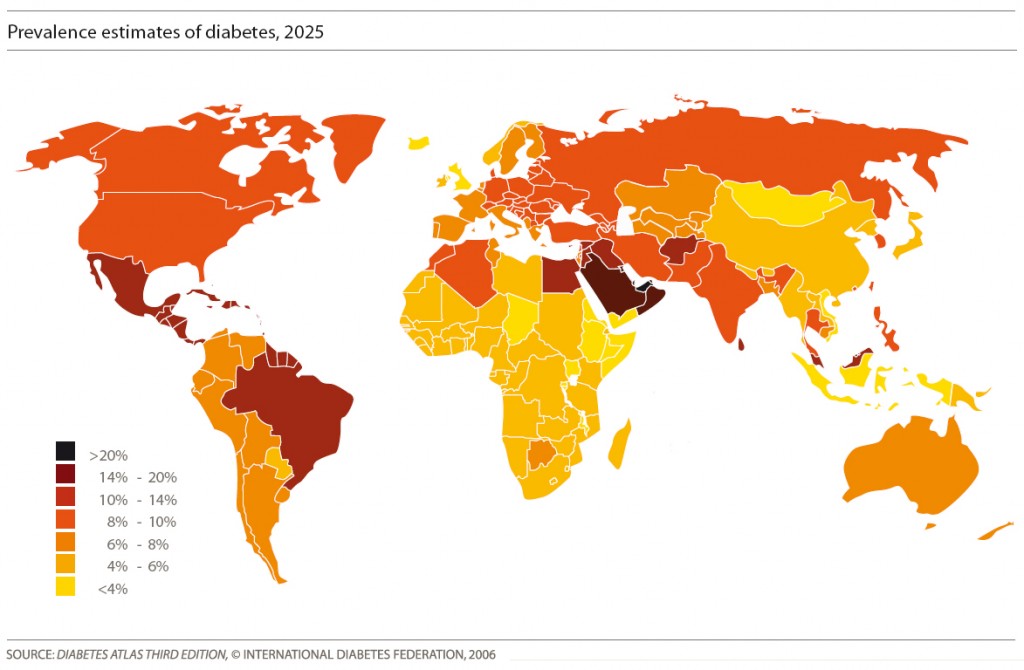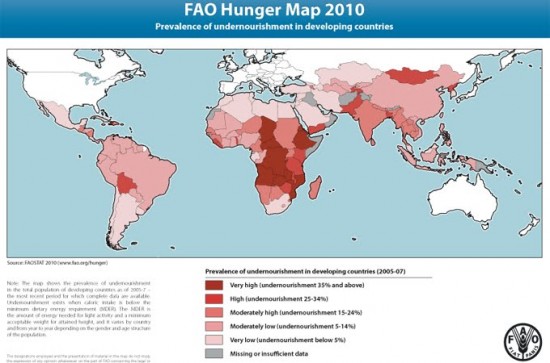The global nutrition market is forecasted to grow at a healthy clip for some time. While world health has benefited greatly from substantial improvements in Human Development Indexes (HDI) around the globe, nutrition and eating habits play key roles in addressing growing health concerns related to obesity, chronic diseases, malnutrition and aging. Fortunately, nutrition and eating habits are also key health drivers that we stand a good chance of being able to better manage and improve.
Global Nutrition Market Forecasts
The Nutrition Business Journal (NBJ) forecasted the global nutrition market would exceed $400 billion by 2014 in its 2010 Global Nutrition Report. PepsiCo, which established a new Global Nutrition Group in 2010, puts the global market for packaged nutrition at $500 billion. The chart below from the 2010 NBJ report shows the development of the global nutrition market.
The size of the global nutrition market rivals other lucrative world markets for food and beverage products. The global snack foods market is forecasted to reach $334 billion by 2015 according to a report by market research firm Global Industry Analysts (GIA).
Functional Foods and Beverages
Functional foods and beverages are a core segment of the global market for packaged nutrition products. Originating in Japan more than 20 years ago, functional foods and beverages refer to products that have been fortified to achieve specific health benefits. Prominent examples of functional foods and beverages include: sports and energy drinks, vitamin- and antioxidant-enriched milk and juices, whole grains and other products fortified with omega-3 fatty acids (fish oil) and probiotic yogurt products (which contain microorganisms that aid digestion).
Nutraceuticals
Nutraceuticals refer to nutrient supplements that can improve health and well-being while helping to prevent nutrition-related health conditions. Some analysts classify the nutraceuticals market more broadly by including functional foods and beverages. Others distinguish nutraceuticals as nutrition supplements that are produced from foods but sold in a medicinal form, such as capsules, tablets, powders, solutions and potions.
World Market for Clinical Nutrition Products
The market for global clinical nutrition products is expected to reach $34.5 billion by 2015 according to a GIA study. Infant nutrition is the “largest and fastest growing segment” in the global clinical nutrition products market. Clinical nutrition products include infant formula with protein, antioxidants, probiotics, prebiotics, enriched and omega-3 fatty acids such as ARA, EPA and DHA.
Role of Nutrition in World Health Issues
Nutrition and eating habits feed directly into a host of personal health issues that directly impact individual quality of life and national healthcare systems. Poor eating habits, combined with limited activity, are a leading contributor to obesity, which increases the risk of serious long-term illnesses such as diabetes, heart disease, asthma and cancer, and shortens life expectancies. Even for those who manage to escape these problems, an unhealthy, high calorie diet lacking in essential nutrients can lead to weight control issues, low energy and self-esteem and an overall lower quality of life.
On the other hand, more than one billion people around the world, mostly in developing countries, suffer from malnutrition. These people either go hungry altogether or consume diets that lack essential nutrients for staying healthy. As a result, they face a high risk of succumbing to nutrition-related illnesses and high mortality rates.
Obesity Around the World
Obesity is one of the biggest public health issues in many countries around the world. In 2006, the number of overweight people in the world overtook the number of malnourished, underweight people for the first time.
Since 1980, obesity rates have doubled or tripled in many OECD countries. Today, 50 percent or more of the population is overweight in almost half of OECD countries. The chart below shows the past and forecasted overweight incidences for selected OECD countries.
While the U.S. has long topped world obesity rankings, a high incidence of overweight and obese people has increasingly become a global phenomenon afflicting developing as well as developed countries. In China, overweight rates doubled from 13.5 to 26.7 percent between 1991 and 2006 according to the OECD, while the prevalence of diabetes reportedly reached a level similar to the U.S. at over 92 million cases. In Brazil, obesity rates tripled in men and almost doubled in women between 1975 and 2003.
In January, 2011, CNN reported on OECD data indicating Mexico has the world’s highest national share of people 15 and older who are overweight or obese at 69.5 percent of the population. Mexico’s Institute for Public Health reports that diabetes, of which obesity is a contributing factor, is the leading cause of mortality in the country.
Adults with a Body Mass Index (BMI) over 30 are generally considered obese, while those with a BMI over 25 but less than 30 are classified as overweight. BMI can be calculated by the formula: weight (kg) / [height (m)]^2. The corresponding BMI with the same risk level may be higher or lower than 30 for some ethnic groups. The chart below shows the overweight and obesity percentages for the OECD countries.
Diabetes
Diabetes affects more than 285 million people globally according to estimates by the International Diabetes Federation (IDF) and IDF Diabetes Atlas. With seven million people developing diabetes each year, that number is expected to grow by more than 50 percent in the next 20 years to 438 million people. The chart below shows the IDF’s 2006 forecast of diabetes incidence rates around the world in 2025. (Click on the image to view the full-size map in a separate browser tab or window.)
Malnutrition
Malnutrition sits at the other end of the food intake spectrum from obesity, at least in terms of calories. The United Nations (U.N.) estimates that close to one billion people in the world today are hungry.
FAO Hunger Map
The U.N. Food and Agriculture Organization’s (FAO) hunger map shows the prevalence of undernourishment in developing countries. As of 2005-7, a good portion of Sub-Saharan Africa fell into the highest “Very high” category of malnutrition with undernourishment of 35 percent and above. In India, nearly 20 percent of the adult population and 44 percent of young children under five years of age were undernourished according to a 2009 report on nutraceuticals by global services firm Ernst & Young (E&Y). Fortunately, the continued rapid economic development of a number of countries, including China and India, has already contributed to reducing undernourishment from some of the levels shown in the FAO map below.
Calories but Not Nutrients
Malnutrition even plagues a substantial portion of certain populations that do not go hungry in terms of calories. In India, E&Y found that 570 million people consumed sufficient levels of calories but not nutrients. Of that group, 340 million people who also consumed higher than recommended levels of dietary fats, “could be the largest contributor in making India the future cardiovascular and diabetes capital of the world.”
Middle Class
The rapid economic growth and demographics of China, India, Brazil and other developing countries are expected to give rise to a large middle class whose consumption would help drive economic development and the expansion of the global economy. At present, the jury is out on whether this new middle class will lead to an improvement or decline in global health and well-being. As people in developing countries become more affluent, they have more income to invest in functional foods and beverages and other healthy food products. On the other hand, there has also been a tendency for the newly affluent to forgo the staple vegetables and fruits they may have grown up eating in favor of other offerings that have tended to be less nutritious to date.
Aging
Aging is another prominent global trend driving the world market for nutrition products. Due to increasing life expectancy and low fertility rates, people age 65 and over account for a much larger, growing share of many national populations. The chart below shows the significant increase in the old age dependency ratio, or the ratio of people age 65 and over to the working age population ages 15-64.
With more of the world going gray and staying that way longer, consumers and healthcare providers are turning to functional foods and beverages to help prevent and manage the physical and mental effects of old age.
Prevention vs. Treatment
The old saying “an ounce of prevention is worth a pound of cure” goes a long way when it comes to global nutrition and healthcare. Prevention tends to come at a fraction of the physical, emotional and financial costs involved in dealing with chronic diseases down the road. A study by the OECD and World Health Organization (WHO) found food labeling to be one of the most efficient and effective interventions that contributed to preventing chronic diseases linked to unhealthy diets, sedentary lifestyles and obesity.
Efforts to Improve Global Nutrition and Public Health
On the positive front, while there is still a ways to go, consumers, companies and healthcare systems, particularly in more developed countries, have increasingly recognized the importance of taking measures to prevent undesirable health outcomes. Consumers have devoted more time to reading labels and asking questions about what goes into food products and results from eating them. Food companies have responded by improving the health profile of product formulations and expanding offerings of functional foods and beverages. Governments and organizations have taken action by regulating the use of harmful ingredients, such as trans fats, product packaging and labeling and the dissemination of information that consumers need to make good decisions about their eating habits, healthcare and well-being.
- Food Products and Labels – Global food companies like PepsiCo, Nestle and others have made significant investments in improving many products and developing their health and wellness platforms. These efforts involve commitments to continue achieving significant reductions in sodium, saturated fat and added sugar per serving across products and brands in developed and developing country markets. Health and wellness initiatives include fortifying grains, dairy, packaged and prepared foods with vitamins, antioxidants and other beneficial ingredients, including fiber and omega 3. Going forward, food companies can continue to innovate and develop healthier products and ensure that consumers have easy access to key nutrition information on product labels that will help them make good, informed decisions.
- Regulatory Actions – Governments can play a valuable role in regulating the use of harmful ingredients and promoting a healthy food culture. In the U.S., New York City took a lead role in banning the use of trans fats and raising public awareness about their harmful properties.
- Education Initiatives – Companies, organizations and governments should work together to raise awareness about the link between good nutrition and living a healthy, long life. School health curriculums should strive to educate students on nutrition and the benefits of healthy eating habits in an engaging, memorable manner. Education efforts should encompass the health benefits of positive lifestyle habits that go beyond food and nutrition to include exercise, the avoidance of smoking and excessive alcohol consumption and other fundamental aspects of health and well-being.
- Malnutrition – Economic development has historically been the key driver of sustainable access to a healthy diet sufficient in calories and nutrients. In places that have had difficulty proceeding down this path, governments and organizations have an especially important role to play in improving access to essential staple foods and nutrients as well as key agricultural inputs and techniques. Collective action, international collaboration and the application of science and technology can improve crop yields and farm incomes while mitigating the impact of high input and food prices. Multinational companies can contribute to these efforts by leveraging their extensive distribution networks and sophisticated logistics capabilities to help deliver food items and agricultural inputs to remote locations.
The impending rapid expansion of the middle class in developing countries presents a rare opportunity to maximize the benefits of these efforts to improve global nutrition, health and wellness. As consumers increasingly enjoy the relative affluence of their new economic status, they will get to decide whether to adopt dietary and nutritional habits that improve their health or ones that raise the risk of incurring chronic conditions that impair quality of life and burden healthcare efforts. Companies, governments, organizations and individuals all have important roles to play in making it possible for people in developing and developed countries to choose healthy eating habits and lifestyles that maximize public health, quality of life and well-being.
Related articles and content:
Global Sherpa country profiles and topic pages: Brazil, China, India, BRIC Countries, Charts and Tables, Development, Sustainability, World Rankings
Urban Design Fights Obesity in NYC
Diabetes, Obesity Linked to Fish Diet, Development
What’s for Dinner: Sushi or Fish Sticks?
Aging 150 Year Old Japanese in Abundance – Health Secrets and Population Issues
World Food Prices Hit Record High


